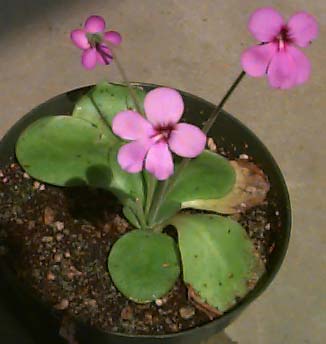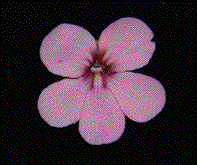
|
|

Pinguicula X 'Titan' is
named after the nickname (verbal icon) for California State
University, Fullerton. The name was chosen because of the large size
the plant can reach. At its maximum extent, the leaves can hang over
a six inch pot. This hybrid was created at California State
University, Fullerton's Biological Sciences Greenhouse Complex by Leo
C. Song, Jr. on 17 July 1987 using P.agnata-CSUF
(fragrant form) as the seed parent and P. sp. collected
by David Verity near Guanajuato, Mexico in 1975 as the pollen parent.
It may be P. macrophylla.
The pollen parent forms a hibernaculum below the surface of the
ground, sometimes at a depth of over 1/2 inch depending on the
hardness of the growing medium. Flowers of the pollen parent are
similar in form to P. gypsicola. P. X
'Titan' also forms a large subterranean hibernaculum during a
relaltively short dormant period. The leaves resemble more the pollen
parent in having a longer and more pronounced petiole than the seed
parent, P. agnata. However, the flower shape definitely
favors the seed parent, but the blue edges have been replaced with an
even magenta glow. A slight fragrance is also noted. So far, the
P. agnata we have been using is the only fragrant ping
we have. The actual taxonomic status of this plant is still
uncertain.
|
|
|
|
|
Hibernaculum has fully opened. Note remnants of previous growing season's leaves. The outer new leaves, which are thick and non-glandular, but with coarse white hairs on the top surface. These leaves are ideal propagation material. For an idea of size, the larger gravel-like white "pebbles" are pieces of coarse perlite and are about 1/4 inch long. The grains of sand are silica sand #20 mesh. |
'Titan' is very vigorous and is quite easy to grow. We use
a general mix for carnivorous plants (CP) to which a bit of dolomite
and gypsum is added. A 2 inch layer of perlite is placed at the
bottom of the pot for added drainage and enhanced aeration. At Cal
State, it is growing under lights and natural lighting through a west
window in the unheated headhouse.
Currently, P. X 'Titan' is being sold by Booman
Floral of Vista, California from clonal material distributed before
this name was chosen, as the "Starfish Plant" at nurseries, such as
Home Depot. In stores, it outlasts all other CP, flowering in bag
after the Venus' Fly Traps, sundews, and North American pitcher
plants have died.
 |
Close-up of flower of Pingucula X 'Titan' which are slightly fragrant. the small notch on the upper right petal is atypical. |
The official registration of this cultivar will be published with a more formal description in the Carnivorous Plant Newsletter (CPN), the official organ of the International Carnivorous Plant Society, Inc. (ICPS), which is the official registration authority of carnivorous plant cultivars.
|
|
|
Revised 26 August 1999